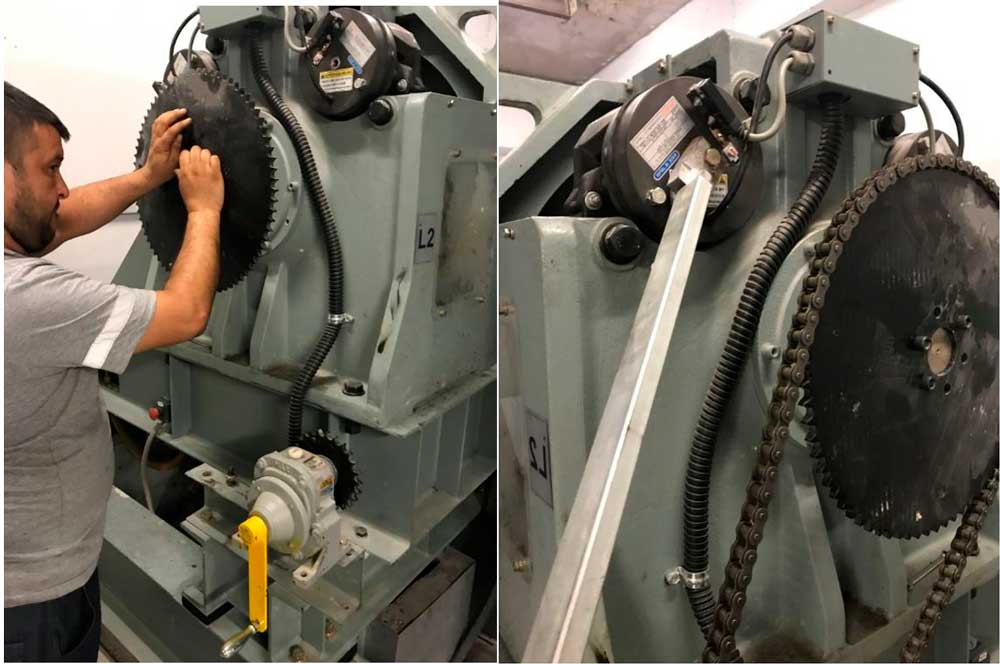Evacuation of passengers trapped in elevators is an issue emphasized by the standards. The passengers should be rescued from a cabin that stops between the floors for any reason. For that reason, various measures should be taken:
- The distance between adjacent floors cannot exceed 11m (This distance is 7m in firefighter elevators). If it exceeds 11 m, an emergency door should be built.
- For two elevators operating in the same shaft, if an emergency door cannot be built, a device that will allow passage between the cabins (consisting of a door opening on the side walls of the cabins and a bridge between them) should be installed.
- In case of a power outage, the elevator should be moved to the floor through hardware provided on the control panel or motor.
- When the elevator is at an unlocking zone (20 cm above or below the landing level), if it does not operate, it should be possible to open the car door with a force less than 300 N, even if there is power in the car door driver and motor.
The aim of the above rules is to rescue passengers trapped in elevator cars in any case. Rescue equipment should be available outside without requiring intervention into the well. The general method is to turn on the motor brakes electrically or mechanically and to move the elevator toward the direction of the cabin or counterweight, which is heavier. The direction may be either way, depending on the weight. However, there are some situations where passengers cannot be rescued from the cabin, even when it is compliant with the standard.
According to EN 81-20: 5.9.2.2.2.9, With the brake manually released and the car loaded within the limits of (q – 0,1) Q and (q + 0,1), it shall be possible to move the car to an adjacent floor by:
- either natural movement due to gravity; or
- manual operation
Therefore, if the passenger weight in a cabin, balanced by 50%, is between 40% and 60% of the cabin capacity, the cabin may not move. In the past, some accidents occurred because of this. For example, in an accident that occurred in Greece, about 40 children were stuck in the cabin for hours. When the cabin capacity is too big, it becomes difficult to disrupt the state of balance under current conditions. To prevent it, a flywheel is provided to move the motor manually in machine-room elevators.
Unfortunately, such equipment is only provided for machine-room and high-speed elevators. For machine-room-less elevators, which constitute the majority of elevators, there is no option other than using the hardware that opens the motor brakes.
Therefore, especially for buildings like hospitals and schools, it is essential to provide equipment that can move the cabins even when they are in a state of balance.
Another problem related to rescue operation is experienced with the automatic rescue systems, which cuts in in case of a power outage and thus enable the cabin to move to the nearest floor. Such systems consist of equipment that automatically moves the cabin to a floor by converting the direct current to alternating current with the help of battery supply and an inverter. Many manufacturers optionally provide this system in elevators without a machine room. However, building contractors do not purchase this option if it is not written in specifications. Moreover, some manufacturers do not recommend this option because it would increase the costs due to the need for bigger batteries for the elevators of high-rise buildings, which have greater capacities and speeds. For this, the manufacturers state the expense of battery maintenance as a reason, and also claim that the generator of the building will cut in and move the elevator. Although they are right to some extent, reaching a conclusion by making a risk assessment is necessary. Power outages are not only caused by network errors. Failures of the protection equipment in the building installation can also cause a group of elevators to shut down. They may open the circuit by cutting the entire energy line at the thermal switches and residual current devices. Or, in large buildings where there are many elevator groups, transformer failures can cut the power of only a certain part of the building. In this case, generator does not cut in. It may take a long time for authorized people to intervene in the machine rooms. The people stuck in crowded cabins can give unpredictable reactions. Therefore, rescue system should start after an announcement and then the cabin should be moved. The benefit of such systems is worth its cost. Such systems should be installed in hospitals, schools and social facilities due to the importance of these buildings.
Unfortunately, people stuck in elevators give unusual reactions. The primary measure to be taken for preventing people’s overreactions is to activate communication with the passengers and tell them they will be rescued in a short time. In such cases, people often try to open the doors with panic. According to EN 81-20, for opening the cabin doors between the floors a force smaller than 1000 N is required for maximum 50 mm. On the other hand, even such an opening is enough to inactivate the door’s electric contact. Automatic rescue systems cannot be activated when the safety contact is switched. Therefore, even if it is not mandatory in elevators with automatic rescue system, hanging a warning message that passengers can see and read will be useful. Additionally, communication requirements should be compliant to EN 81-28, and the communication system should be working. According to EN 81-28, alarm devices should test themselves. Although many manufacturers make installations in accordance with EN 81-20, if their alarm devices are not compliant with EN 81-28 they are not included in security checklists.
In the case of a power outage, emergency lights capable of ensuring a lighting intensity of at least 5 lux for 1 h should be present in and above the car. In previous installations, lighting power was 1 W for 1 h. Therefore, feeding by any button was sufficient to provide the amount of illumination. The amount of illumination is very low in elevators that were installed before 2017 and compliant with EN 81-1. Passengers may be panicked because they are trapped in darkness within the cabin. So, the lighting system in old elevators should be strengthened.
EN 81-20 brought additional articles that increase the safety levels against the risks of being stuck in elevators. Reaching levels above the minimum safety requirements will even increase the life quality of people and increase the trust in manufacturers. Although costs are very important, such equipment, which can be purchased with very small amounts when compared with the total price of elevators, will definitely be worth the money spent.
Get more of Elevator World. Sign up for our free e-newsletter.









